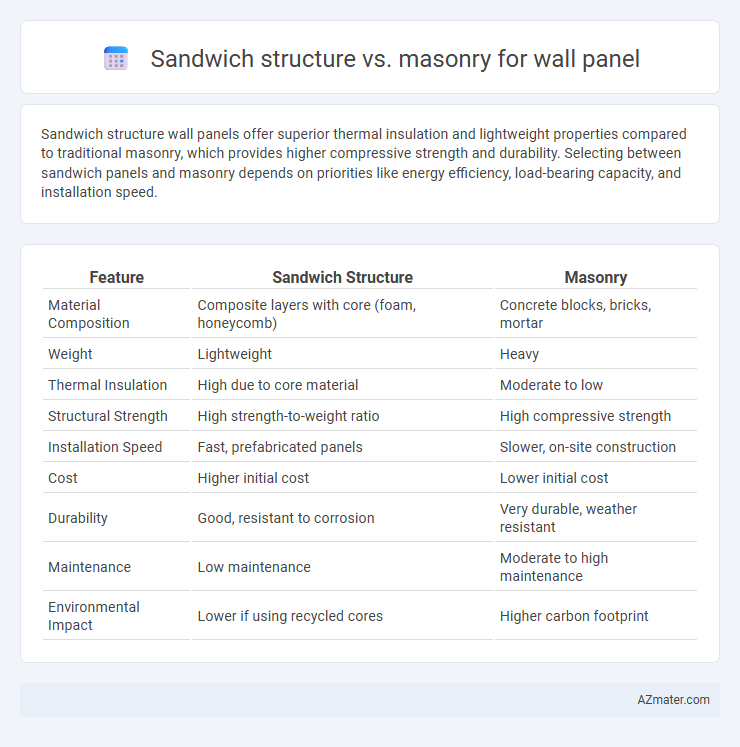Sandwich structure wall panels offer superior thermal insulation and lightweight properties compared to traditional masonry, which provides higher compressive strength and durability. Selecting between sandwich panels and masonry depends on priorities like energy efficiency, load-bearing capacity, and installation speed.
Table of Comparison
| Feature | Sandwich Structure | Masonry |
|---|---|---|
| Material Composition | Composite layers with core (foam, honeycomb) | Concrete blocks, bricks, mortar |
| Weight | Lightweight | Heavy |
| Thermal Insulation | High due to core material | Moderate to low |
| Structural Strength | High strength-to-weight ratio | High compressive strength |
| Installation Speed | Fast, prefabricated panels | Slower, on-site construction |
| Cost | Higher initial cost | Lower initial cost |
| Durability | Good, resistant to corrosion | Very durable, weather resistant |
| Maintenance | Low maintenance | Moderate to high maintenance |
| Environmental Impact | Lower if using recycled cores | Higher carbon footprint |
Introduction to Wall Panel Construction Methods
Sandwich structure wall panels consist of two outer layers bonded to a core material, offering high thermal insulation, lightweight construction, and superior strength-to-weight ratio. Masonry wall panels are made from stacked bricks or blocks bonded with mortar, providing excellent durability, fire resistance, and sound insulation. Choosing between sandwich structures and masonry depends on project requirements such as thermal performance, structural load, installation speed, and cost-effectiveness.
Overview of Sandwich Structure Panels
Sandwich structure panels consist of two rigid outer layers bonded to a lightweight core, offering superior thermal insulation and high strength-to-weight ratios compared to traditional masonry walls. These panels provide enhanced energy efficiency, faster installation times, and improved durability against environmental factors. The composite design of sandwich panels results in reduced structural load and increased flexibility in architectural applications.
Key Features of Masonry Wall Panels
Masonry wall panels offer superior thermal mass, providing excellent insulation and energy efficiency by stabilizing indoor temperatures. Their high compressive strength and durability ensure long-lasting structural integrity and resistance to fire, pests, and moisture. Masonry panels also enhance sound insulation, making them ideal for noise reduction in both residential and commercial buildings.
Structural Performance Comparison
Sandwich structures, composed of two strong outer layers bonded to a lightweight core, offer superior strength-to-weight ratios and enhanced insulation compared to traditional masonry wall panels. Masonry panels, typically made from brick or concrete blocks, provide high compressive strength and durability but tend to be heavier and less efficient in thermal performance. The sandwich panel's ability to distribute loads across its layers results in improved flexural strength and resistance to impact, making it a preferable choice for modern construction demanding both structural efficiency and energy savings.
Thermal and Acoustic Insulation Properties
Sandwich structures for wall panels offer superior thermal insulation due to their multi-layer composition, typically combining rigid foam cores with outer facings that reduce heat transfer effectively. Masonry panels, while durable and fire-resistant, tend to have higher thermal conductivity, leading to less efficient insulation without added insulating materials. In terms of acoustic performance, sandwich panels provide enhanced sound absorption through their layered design, whereas masonry walls generally transmit more noise unless supplemented with specialized acoustic treatments.
Installation and Construction Speed
Sandwich structures offer significantly faster installation and construction speeds for wall panels due to their prefabricated nature and lightweight components, reducing onsite labor and time. Masonry wall panels require extensive bricklaying or blockwork, demanding more skilled labor and longer curing periods, which slows overall project timelines. The streamlined assembly process of sandwich panels enhances efficiency and accelerates project completion compared to traditional masonry methods.
Cost Efficiency Analysis
Sandwich structure wall panels offer superior cost efficiency compared to masonry by reducing material and labor expenses through prefabrication and lightweight components. The thermal insulation properties of sandwich panels minimize long-term energy costs, enhancing overall savings. Masonry walls, while durable, generally incur higher initial costs and longer construction times, impacting project budgets negatively.
Durability and Maintenance Considerations
Sandwich structure wall panels offer superior durability due to their reinforced core materials, such as foam or mineral wool, which provide enhanced resistance to impact, moisture, and thermal variations compared to traditional masonry panels. Maintenance requirements for sandwich panels are generally lower, as their factory-finished surfaces resist corrosion, mold, and cracking, reducing the frequency of repairs and repainting common in masonry walls. Masonry wall panels, while robust in load-bearing capacity, often demand more intensive upkeep to address issues like mortar joint deterioration, efflorescence, and surface weathering over time.
Environmental and Sustainability Aspects
Sandwich structures for wall panels offer superior thermal insulation and reduced material usage compared to traditional masonry, leading to lower energy consumption and carbon emissions during building operation. The use of eco-friendly core materials, such as recycled foam or natural fibers, further enhances the sustainability profile by minimizing resource depletion and waste generation. In contrast, masonry panels, often composed of energy-intensive clay or concrete blocks, have a higher embodied carbon footprint and limited thermal efficiency, making sandwich panels a greener alternative for sustainable construction.
Choosing the Best Wall Panel System for Your Project
Sandwich structure wall panels offer superior thermal insulation and lightweight properties compared to traditional masonry, making them ideal for energy-efficient and fast-track construction projects. Masonry panels provide exceptional durability, fire resistance, and sound insulation, suitable for load-bearing applications requiring long-term stability. Selecting the best wall panel system depends on project requirements such as structural strength, insulation needs, installation speed, and budget constraints.

Infographic: Sandwich structure vs Masonry for Wall panel
 azmater.com
azmater.com